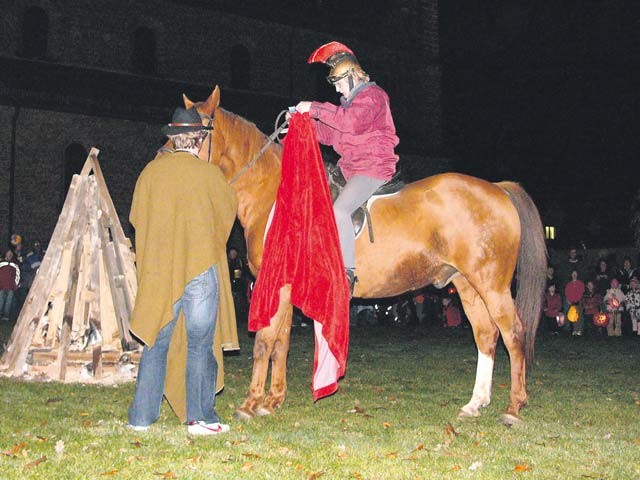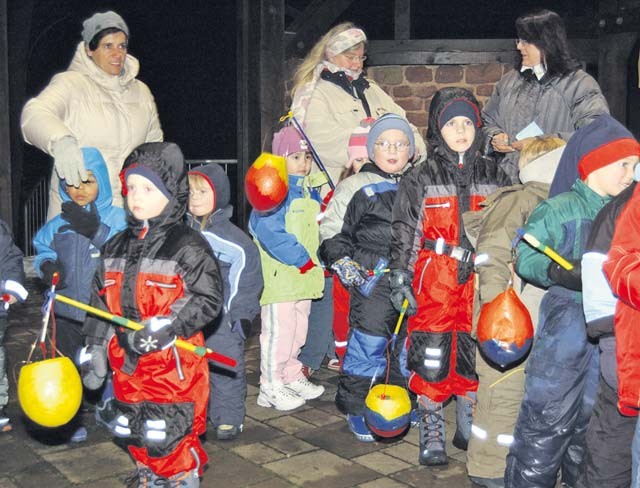
During a Martin’s play near the church in Ramstein-Miesenbach, St. Martin divides his coat and shares it with a beggar.
Wednesday is St. Martin’s Day, and children and parents will walk in lantern processions that evening or the night prior to honor St. Martin, the patron of the poor and friend of children.
In Kaiserslautern, Ramstein, Landstuhl and other villages of the KMC, parishes and kindergartens organize lantern processions where children carry lanterns they created in their kindergarten or school and sing Martin songs. Usually the walk starts at a church and goes to a public square. A man on horseback dressed like a Roman soldier, representing St. Martin, accompanies the children. When they reach the square, a Martin’s play is then performed, a bonfire is lit and Martin’s pretzels are distributed.
In Kaiserslautern, a big lantern procession will start at 6 p.m. Wednesday from St. Martin’s Church near St. Martinsplatz at the beginning of Steinstrasse and end in front of the Rathaus, city hall, where St. Martin will divide his coat and a bonfire will be lit.
In the city of Landstuhl, a St. Martin’s parade will begin at 6 p.m. Tuesday with a play at Heilig-Geist-Kirche and end at the Altenzentrum, a meeting place for senior citizens, with a fire, Martin’s pretzels, tea and Gluehwein.
In Ramstein-Miesenbach, festivities will begin at 5:30 p.m. Wednesday in the Catholic church. A lantern procession with St. Martin on a horse and musicians will go through town. A St. Martin’s play will be presented, a bonfire will be lit and pretzels and Gluehwein will be available.
Besides the traditional lantern processions, other festivities honoring St. Martin are scheduled to take place.
In the wine growing village of St. Martin, south of Neustadt, the Martinus Wine Fest will be celebrated today through Sunday and Wednesday.
Wallhalben will host a Martini market with vendors’ stands, food and beverage booths on Saturday.
Dahn will hold its traditional Martini market with vendors and a small carnival on Sunday. Stores will be open in the afternoon.
St. Martin dates back to around the year 316 when Martin of Tours was born as the son of a Roman civil servant. At age 15, he joined the Emperor’s cavalry.
One cold winter day, he was riding through the country when a shivering beggar came his way asking for alms. Since Martin had neither food nor money, he cut his robe in half with his sword and gave a piece to the freezing man.
Supposedly, the following night Jesus appeared in Martin’s dream and explained how he had been the freezing beggar to whom Martin had given half his robe to.
This event changed the soldier’s life. He left the army, got baptized and became a student of Hilarius of Poitiers. In 356, after Martin’s teacher was banned and he failed to convert his father and others to the teachings of Hilarius, he left for an island near Genua, where he lived as a hermit.
In 360, Martin gave up his solitary life to join Hilarius again who returned to Poitiers. In 361, he founded the first Gallic monastery in Liguge. In 371, the clergy and the people from Tours elected him for bishop. In 375, he established Marmoutier, a monastery for ascetic life and a school for bishops.
Martin kept trying to evangelize pagans. On Nov. 8, 397, during a pastoral trip to Candes, he died. Thousands of monks, consecrated virgins and others went to his funeral Nov. 11.
Years later, a basilica with the St. Martin Abbey was built on top of Martin’s gravesite. King Chlodwig elected Martin as patron of the Francs.
The tradition of the lanterns goes back to former times when people lit candles to honor a saint and lanterns were put up everywhere in town when a bishop came to visit.
The custom of lighting a bonfire after the lantern procession represents the beginning of festivities. In former times, most of the work on the fields had been completed and it was then time to celebrate, drink and eat. Traditionally, a fat goose and sweet bread were served.

Children with handcrafted lanterns walk in lantern processions to honor St. Martin.


